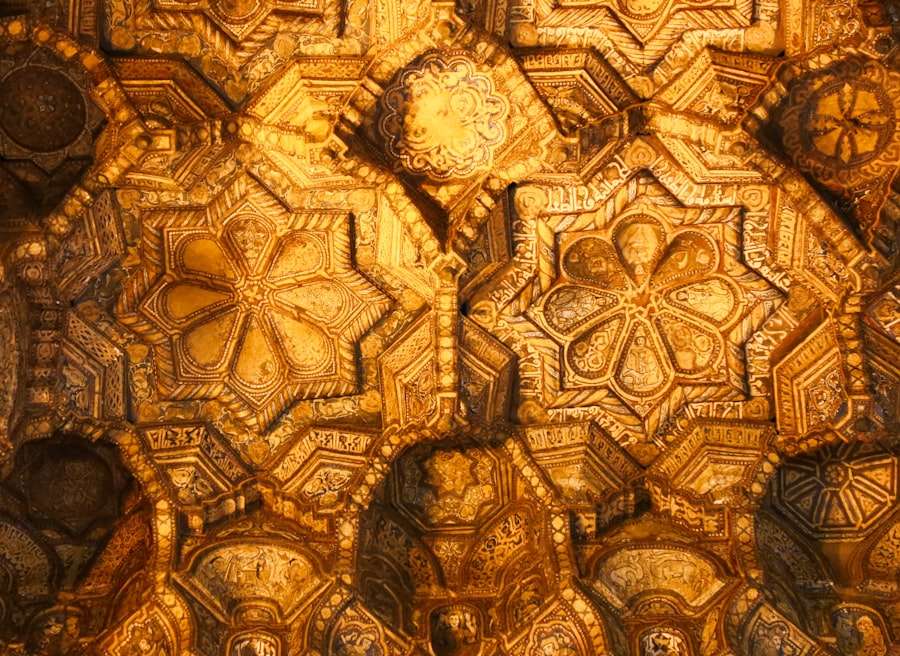What is the meaning of the Celtic knot symbol?

The Celtic knot, also known as the mystic or endless knot, is an ancient symbol with origins dating back to the pre-Christian era. It is associated with the Celtic people who inhabited parts of Europe, including the British Isles, France, Spain, and Germany. The intricate, interwoven patterns characteristic of Celtic knots are believed to have evolved from the artwork of early Celtic tribes, who were renowned for their skilled craftsmanship in metalwork, jewelry, and stone carvings.
While the exact origins of the Celtic knot symbol remain uncertain, it is generally accepted that the Celts used these complex designs to represent the interconnectedness of life, nature, and the spiritual realm. The knotwork patterns frequently appeared in Celtic artwork, including illuminated manuscripts such as the Book of Kells, as well as on stone crosses and other religious artifacts. The symbolism of the endless knot likely reflected Celtic beliefs in the cyclical nature of life, death, and rebirth.
The unbroken lines of the Celtic knot were thought to symbolize eternity and the interconnectedness of all things in the universe. As the symbol spread to other cultures, it evolved and gained additional significance. During the early medieval period, the Celtic knot became intertwined with Christian symbolism.
The intricate designs were incorporated into Christian artwork and architecture, representing concepts such as the Holy Trinity and the interconnectedness of body, mind, and spirit. The Celtic knot continues to be a widely recognized symbol, appreciated for its aesthetic appeal and rich cultural significance.
Key Takeaways
- The Celtic knot symbol has its origins in the artwork of the ancient Celts, dating back to around 450 AD.
- The Celtic knot is often associated with concepts of eternity, interconnectedness, and the cyclical nature of life.
- There are many variations of the Celtic knot, each with its own unique meaning, such as the trinity knot representing the Christian Holy Trinity.
- The Celtic knot has deep cultural and historical significance, being found in Celtic art, jewelry, and manuscripts throughout history.
- In modern times, the Celtic knot is often used in jewelry, tattoos, and other forms of art, representing heritage, spirituality, and connection to the past.
Symbolism and significance of the Celtic knot
The Symbolism of Eternity
The intricate and interwoven patterns of the knotwork are often seen as a representation of eternity, as they have no beginning or end. This symbolism is often associated with concepts such as eternal love, friendship, and loyalty, making the Celtic knot a popular choice for jewelry and gifts exchanged between loved ones.
Interconnectedness and Unity
In addition to its representation of eternity, the Celtic knot is also believed to symbolize interconnectedness and unity. The unbroken lines of the knotwork are thought to represent the interconnectedness of all things in the universe, as well as the cyclical nature of life, death, and rebirth. This symbolism is deeply rooted in Celtic spirituality and is often associated with concepts such as harmony, balance, and the interconnectedness of all living beings.
Protection and Good Luck
The Celtic knot is also seen as a symbol of protection and good luck. In Celtic tradition, it was believed that wearing or displaying a piece of jewelry or artwork featuring the Celtic knot would bring protection from harm and ward off evil spirits. The intricate patterns of the knotwork were thought to create a barrier against negative energy, making it a popular choice for talismans and amulets.
Timeless Beauty and Profound Significance
Overall, the Celtic knot holds a myriad of meanings and symbolism that have resonated with people for centuries. Its timeless beauty and profound significance continue to make it a popular choice for jewelry, tattoos, and artwork, as it serves as a reminder of the eternal interconnectedness of all things in the universe.
Variations of the Celtic knot and their meanings

The Celtic knot comes in a wide variety of designs and patterns, each with its own unique meanings and symbolism. Some of the most common variations of the Celtic knot include the trinity knot, spiral knot, and Dara knot, each of which holds its own distinct significance. The trinity knot, also known as the triquetra, is one of the most well-known variations of the Celtic knot.
It features three interlocking loops that are often interpreted as representing the Holy Trinity in Christian symbolism – the Father, Son, and Holy Spirit. In Celtic tradition, the trinity knot is also associated with concepts such as mind, body, and spirit; past, present, and future; and earth, sea, and sky. This variation of the Celtic knot is often used to symbolize unity, balance, and interconnectedness.
The spiral knot is another popular variation of the Celtic knot that features a continuous spiral pattern. This design is often associated with concepts such as growth, evolution, and journey. The spiral is a universal symbol found in many cultures around the world and is often interpreted as representing life’s journey and the cyclical nature of existence.
In Celtic tradition, the spiral knot is thought to symbolize personal growth, transformation, and the interconnectedness of all living beings. The Dara knot is a variation of the Celtic knot that features an intricate pattern resembling oak leaves or branches. This design is often associated with concepts such as strength, wisdom, and endurance.
In Celtic tradition, the oak tree was revered for its strength and longevity, making the Dara knot a powerful symbol of resilience and inner strength. Overall, the variations of the Celtic knot each hold their own unique meanings and symbolism that have resonated with people for centuries. Whether it’s the trinity knot representing unity and balance or the spiral knot symbolizing life’s journey, each variation serves as a powerful reminder of the eternal interconnectedness of all things in the universe.
Cultural and historical significance of the Celtic knot
The Celtic knot holds deep cultural and historical significance within Celtic tradition and beyond. The intricate designs of the knotwork have been an integral part of Celtic art and craftsmanship for centuries, serving as a powerful symbol of interconnectedness, eternity, and spirituality. In ancient Celtic culture, the intricate patterns of the Celtic knot were often used in artwork such as illuminated manuscripts like the Book of Kells, as well as on stone crosses and other religious artifacts.
These designs were thought to hold deep spiritual significance for the Celts, representing concepts such as eternity, unity, and protection from harm. The Celts were a deeply spiritual people who believed in the interconnectedness of all things in the universe, and the symbolism of the endless knot was likely intertwined with their beliefs in the cyclical nature of life, death, and rebirth. During the early medieval period, Christianity spread throughout Celtic lands, bringing with it new interpretations of the Celtic knot symbol.
The intricate designs were incorporated into Christian artwork and architecture, where they were used to represent concepts such as the Holy Trinity and the interconnectedness of body, mind, and spirit. The fusion of Christian symbolism with traditional Celtic knotwork served to further solidify the cultural significance of the endless knot within Celtic tradition. Today, the Celtic knot remains an enduring symbol that continues to hold cultural significance for people around the world.
Its timeless beauty and profound meaning have made it a popular choice for jewelry, tattoos, and artwork that serves as a reminder of the rich cultural heritage and spiritual beliefs of the Celts.
Modern interpretations and uses of the Celtic knot symbol
In modern times, the Celtic knot continues to captivate people around the world with its timeless beauty and profound symbolism. The intricate designs of the endless knot have found new interpretations in various forms of art, jewelry, fashion, and even technology. One popular modern interpretation of the Celtic knot can be seen in jewelry design.
The endless knot is often featured in rings, pendants, bracelets, and earrings that serve as a reminder of eternal love, friendship, and interconnectedness. Many people choose to wear pieces of jewelry featuring the Celtic knot as a way to honor their Celtic heritage or simply as a symbol of personal significance. The timeless beauty of the Celtic knot has also found its way into modern fashion trends.
The intricate patterns of the endless knot can be seen in clothing designs such as scarves, shawls, and even tattoos that serve as a reminder of unity, balance, and protection. In addition to art and fashion, modern technology has also embraced the symbolism of the Celtic knot. The intricate designs have been incorporated into digital art forms such as graphic design and animation to create visually stunning representations that serve as a reminder of eternity and interconnectedness.
Overall, modern interpretations of the Celtic knot symbol continue to evolve and find new uses in various forms of art, fashion, jewelry, and technology. Its timeless beauty and profound meaning have made it a popular choice for people looking to connect with their heritage or simply embrace its powerful symbolism in their everyday lives.
The spiritual and religious meanings of the Celtic knot

The Ancient Celtic Tradition
In ancient Celtic tradition, the intricate patterns of the endless knot were believed to represent concepts such as eternity, unity, interconnectedness, protection from harm, and good luck. The unbroken lines of the Celtic knot were thought to symbolize eternity – with no beginning or end – making it a powerful representation of eternal love, friendship, and loyalty.
A Symbol of Interconnectedness and Unity
This symbolism has made it a popular choice for jewelry exchanged between loved ones or worn as a talisman for protection. In addition to its representation of eternity, the Celtic knot is also associated with concepts such as interconnectedness and unity. The intricate patterns are thought to represent the interconnectedness of all things in the universe – including life’s journey – making it a powerful symbol for personal growth and transformation.
A Fusion of Christian Symbolism
The fusion of Christian symbolism with traditional Celtic knotwork during the early medieval period further solidified its religious significance within Christian tradition. The intricate designs were incorporated into Christian artwork and architecture to represent concepts such as the Holy Trinity – Father, Son, Holy Spirit – further emphasizing its religious significance. Overall, whether it’s through ancient Celtic spirituality or Christian symbolism during medieval times – or even in modern interpretations – the spiritual and religious meanings of the Celtic knot continue to hold deep significance for people around the world.
The enduring popularity and appeal of the Celtic knot symbol
The enduring popularity and appeal of the Celtic knot symbol can be attributed to its timeless beauty and profound meaning that continues to resonate with people around the world. The intricate designs have captivated people for centuries with their representation of eternity, interconnectedness, unity, protection from harm – making it a powerful symbol that transcends time and culture. The timeless beauty of the endless knot has made it a popular choice for jewelry design that serves as a reminder of eternal love, friendship – or simply as a way to honor one’s heritage or embrace its powerful symbolism in everyday life.
In addition to jewelry design – modern interpretations have found new uses in various forms such as fashion trends – clothing designs – digital art forms – graphic design – animation – technology – serving as a reminder of unity – balance – protection – eternity – interconnectedness. Overall – whether it’s through ancient spirituality – Christian symbolism – or modern interpretations –the enduring popularity – appeal – timeless beauty – profound meaning – make it clear why people continue to be captivated by this ancient symbol that holds deep cultural – historical – spiritual significance within Celtic tradition – beyond.
FAQs
What is the Celtic knot symbol?
The Celtic knot is a decorative symbol that features interwoven lines and loops, often with no beginning or end. It is a traditional Celtic design that is often used in art, jewelry, and tattoos.
What does the Celtic knot symbolize?
The Celtic knot is often associated with eternity, as the interwoven lines have no clear beginning or end. It is also seen as a symbol of interconnectedness and continuity, representing the interconnectedness of life and eternity.
What are the different types of Celtic knots?
There are many different types of Celtic knots, each with its own unique design and meaning. Some common types include the Trinity knot (or Triquetra), the Dara knot, the Lover’s knot, and the Shield knot.
Where are Celtic knots commonly found?
Celtic knots are commonly found in Celtic art, jewelry, and tattoos. They are also often seen in architecture, such as in the design of Celtic crosses and in the decoration of ancient Celtic monuments.
Can the Celtic knot symbol be used in modern designs?
Yes, the Celtic knot symbol is often used in modern designs, such as in jewelry, clothing, and home decor. It is also a popular choice for tattoos, often with personal meanings or adaptations.





